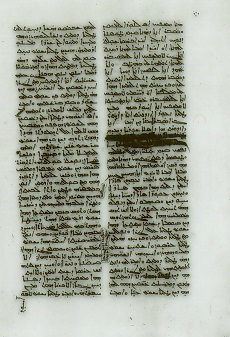Syriac Infancy Gospel of Thomas: Edition in Progress (Part 1)
One of the projects I hoped to finish over this past summer is a long-percolating critical edition of the Syriac tradition of the Infancy Gospel of Thomas. Alas, I was not able to complete the project, but instead of spending my time responsibly and working on it some more, I thought I’d put together a series of posts on the various stages the project has gone through so far. I hope the posts will be of interest to those who work on the text, on Syriac literature, or on text critical work in general.
I became interested in the Syriac tradition of Infancy Thomas while writing my doctoral dissertation, published in 2010 as De infantia Iesu euangelium Thomae graece (Corpus Christianorum Series Apocryphorum 17; Turnhout: Brepols). The dissertation focused on the Greek manuscripts of the gospel, but it is well-known among those who have worked intensely with the text that a number of early versions (Syriac, Latin, Georgian, Irish, and Ethiopian) preserve a form of the text that is more primitive than the Greek (and two related traditions: one in Latin and one in Slavonic). Of these early versions, the Syriac is the earliest, with manuscripts dating to the fifth and sixth century, and in many ways the best witness. So it was necessary that I incorporate the published Syriac manuscripts into my comperanda for determining the original readings of the Greek tradition.

The first Syriac source known to scholars is a fifth/sixth century manuscript in the British Museum (Add. 14484) published by William Wright in 1865 (Contributions to the Apocryphal Literature of the New Testament. London: Williams & Norgate, 1865, pp. 11-16 [text], 6-11 [translation]). It is clearly different from the Greek tradition: it lacks the title, the introduction (with its attribution to “Thomas the Israelite”), and chapters 10, 17, and 18 (which contain miracles with structural similarities to episodes in the Synoptic Gospels); it also lacks much of chapters 7 and 15, but expands chapter six with an interesting speech of the five-year-old Jesus. Once scholars became aware of this manuscript, they began to hypothesize that Infancy Thomas was composed in Syriac, rather than Greek (as it turns out, they were wrong). Despite this high estimation of the Syriac tradition, few scholars made the effort to examine the text in much detail.
A second witness was published by E. A. Wallis Budge in 1899 (The History of the Blessed Virgin Mary and the History of the Likeness of Christ. 2 vols. London: Luzac & Co.) from a personally-commissioned copy of a manuscript from Alqosh; the manuscript has since gone missing. The Alqosh manuscript is a compendium of texts about Mary, placing Infancy Thomas just prior to the Assumption of Mary and after a lengthy complex of stories taking place during the Holy Family’s sojourn in Egypt. The same stories are found in the Arabic Infancy Gospel and it seems that this East Syriac Life of Mary is the immediate predecessor to the Arabic translation. Budge’s manuscript supplies some text missing in Wright’s manuscript—the portions of chapters 7 and 15—but lacks chapters 2, 3, 8, 9, and 19. In addition, the first published source for the Arabic Infancy Gospel (by Henry Sike from an unnamed Bodleian manuscript, in Evangelium Infantiae; vel, Liber Apocryphus de Infantia Salvatoris; ex manuscripto edidit, ac Latina versione et notis illustravit Henricus Sike. Trajecti ad Rhenum: Halman, 1697) contains a number of chapters from Infancy Thomas, reflecting another attempt to combine various infancy traditions. Sources for the Arabic Infancy Gospel published subsequently indicate that the Infancy Thomas material was not original to the text and not present in the Arabic Infancy Gospel’s Syriac source.

A third witness came to light in 1904. This manuscript is housed in Göttingen (Universitätsbibliothek, Syr. 10) and dates from the fifth or sixth century. A. Meyer used the manuscript for his translation of Infancy Thomas in 1924 (“Kindheitserzählung des Thomas.” Pages 93–102 in Neutestamentlichen Apokryphen. Edited by Edgar Hennecke. 2d ed. Tübingen: J. C. B. Mohr), but it was not published until the 1993/1994 (by W. Baars and J. Heldermann, “Neue Materielen zum Text und zur Interpretation des Kindheitsevangeliums des Pseudo-Thomas.” Oriens Christianus 77 [1993]: 191-226; 78 [1994]: 1-32), and only in a collation against Wright’s manuscript. Like the Alqosh manuscript, it makes up for some deficiencies in Wright’s manuscript (portions of chs. 7 and 8) but has some deficiencies of its own (lacking portions of chs. 4, 5, and the entire chs. 14 and 15).

Finally, a fourth manuscript was known to Paul Peeters for his study of apocryphal gospels published in 1914 (Évangiles apocryphes, vol. 2 [Textes et documents pour l’étude historique du Christianisme 18], Paris 1914, p. 304-308). The manuscript is housed at the Vatican Library (Vat. Syr. 159) and dates from the seventeenth century. It contains the Arabic Infancy Gospel in Garshuni, followed by Infancy Thomas in Syriac. Peeters only published chapters 5-8 of the text and only in French translation.
Back in the late nineties, no one, as yet, had tried to bring together the published manuscripts of Syriac Infancy Thomas. There was also no study of additional manuscripts noted in catalogs of European libraries and Near Eastern monasteries. All I could do at the time that I was writing and revising my dissertation was work with what had been made available, despite their inadequacies. But I planned on returning to this material after completing my dissertation and assemble a proper critical edition. I didn’t realize it would take me more than fifteen years to do so.

Have any more Syriac witnesses come to light since 2015? Any more translations available?